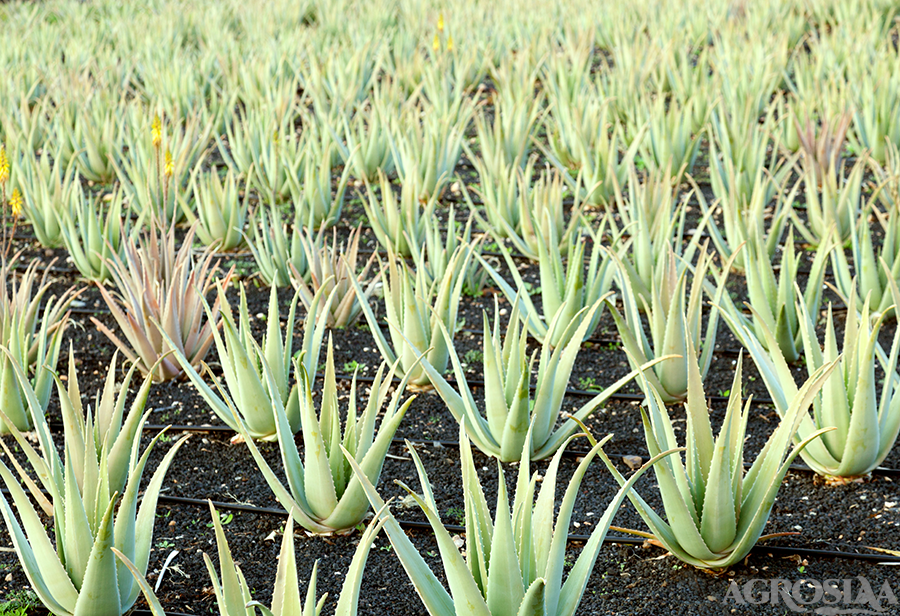Korphad
Liliaceae
Aloe barbadensis
-
Suckers should be planted in July- August to get better field survival and subsequent growth. Under irrigated condition planting can be done round the year except in winter months (November – February)
-
It is grown successfully in marginal to sub marginal soils having low fertility. The plants have tendancy to tolerate high soil pH with high sodium and potassium salts. Its growth is faster under medium fertile heaviour soils such as black cotton soils of central India. Well drained loam to course sandy loam soils with moderate fertility with pH upto 8.5 should be preferred for its commercial cultivation.
The root system of Aloevera doesnot penetrate below 20-30 cm therefore the soil should not be disturbed too deep. 1-2 ploughing followed by levelling are recommended. The field should be divided into suitable plot sizes (10-15 m x 3 m) considering the slope and available source of irrigation.
-
-
Planting method is used for Aloe vera
Planting of suckers in the month of July – August.
Suckers should be planted in about 15 cm deep pits Distance between two rows is 60 cm Distance ebetween two plants is 60 cm. OR Distance between two rows is 60 cm Distance ebetween two plants is 45 cm.
25000 suckers /ha
25000 suckers /ha
The field should be kept free weeds throughout the growing period. Two to three hand weedings followed by light hoeing per year promote growth and suckering. First weeding cum hoeing should be completed with in month after planting . Two weeding cum light hoeing in each year are sufficient to minimize the weed population. Remove regularly diseased plants and dried flower stakes.
Apply 1- 2 kg compost / plant
For slopy land 100 kg /ha NPK. If sufficient quantity of wood ash is available it can be applied in the pits at the time of planting as it helps in establishment of plants and their subsequent growth.
Apply first irrigation just after planting of suckers. Give 2-3 irrigations subsequently till the plants get established . 4-6 irrigations per year for proper growth. Depending upon the availability of water give light irrigation after each picking of leaves.
Two to three hand weedings for growth. Apply weedicides if necessary.
There are no major problems of insects , pests and diseases. Anthracnose , leaf spots Spraying of copper oxychloride. Mealy bugs, termites – it can be managed by applying light irrigations.
-
-
Commercial yield is available from second year to fifth year of transplanting. Generally 3-4 picking per year be taken up depending upon the growth. Cut the matured leaves near ground with sharp knife.
-
15-20 tones /ha fresh leaf.
-
Aloe used in medicine stands for the dried juice which flows from the transversely cut bases of the leaves.
Used as medicinal plants. The succulent mature leaves having bitter juice ar economic parts . Its primary uise is in cosmetic industry for preparation of shampoo, face creams, shaving creams and moisturinzing agents. Use as vegetable and pickle. The leaves possess many medicinal properties and are used to treat fever, enlarged liver and slpleen and other glands skin diseases, gonorrhea constipation., menstrual suppressions, piles , jaundice, rheumatic diseases and also for the treatment of burns and bruises.
For processing of Aloe juice should be allowed to drain from the cut leaves into vessels and then concentrated by evaporation either spontaneous or by frequent boiling. The fresh juice is colourless or yellow but changes to dark brown due to evaporation and boiling. Besides the dried juice the gel is also a very important product. The mucilaginous pulp from the leaf is used in cosmetic industries and in treatment of many human diseases.
Rajasthan, Gujarat, Madhya Pradesh and Maharashtra.
-
-
-










